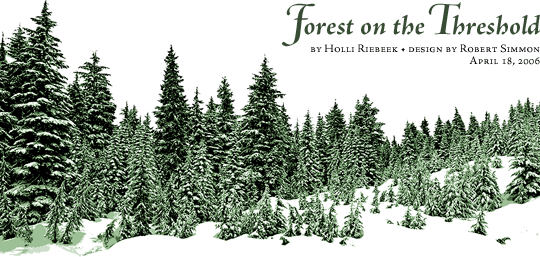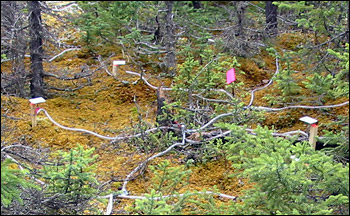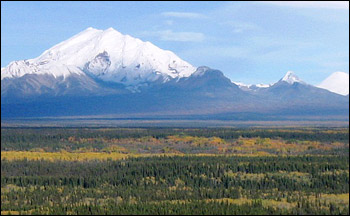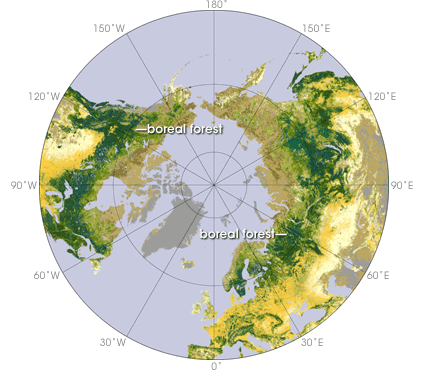

 | The scent of Black Spruce filled the crisp autumn air as Scott Goetz made his way to the array of light detectors spread beneath the canopy of the Alaskan forest. The sun sat low on the horizon, casting long shadows on the forest floor. The long night of winter was quickly approaching, and the detectors would no longer be needed for the year. Though he was there to study the forest, how it absorbed light and carbon and turned them into materials like leaves and bark, it was the wilderness of the place that initially attracted Goetz. He had grown attached to these Northern forests as a graduate student canoeing through the interlinked lakes of Minnesota’s Boundary Waters Wilderness Area while collecting data for a NASA research project. Now an established ecologist, Goetz had spent at least a decade studying and exploring the boreal forests of North America. He knew the forest well. |
||

At the close of the growing season of 2004, Goetz was seeing changes in the forest. The blackened skeletons of trees extended into the distance after fires consumed a record six million acres. Up close, the gold and green leaves of the rustling aspen trees were marbled with white squiggly lines where leaf miners had eaten through them. While both fires and insects were a natural part of the forest’s lifecycle, Goetz hadn’t seen either have such a wide impact on the forest before. But the most disturbing and unexpected change, he had observed months earlier back in his office at the Woods Hole Research Center in Woods Hole, Massachusetts. |
Spruce trees surround light detectors on the floor of the boreal forest in Alaska. Scientists are traveling to sites in the remote North to study the effects of climate change on ecosystems around the world. Scott Goetz uses light detectors to measure the sunlight absorbed by the trees. The scientists combine these measurements with satellite data to gauge the health of the forest. (Photo copyright Daniel Steinberg, Woods Hole Research Center.) | ||

In addition to his research in the forest, Goetz was using satellite data to study how the spruce-rich forests of northern Canada and Alaska recover after large fires. The burned forest was re-growing as he expected, but the unburned forest was behaving strangely. Since the 1990s, scientists have known that increasing global temperatures have lengthened the growing season in the Arctic. With carbon dioxide, one of the key ingredients in photosynthesis, also on the rise, the forest should have been thriving. But it wasn’t. The forest was getting browner, not greener. On the other side of the United States, Alon Angert, a scientist at the University of California, Berkeley, noticed a strange trend in the forest, too. Angert was tracking carbon dioxide in the atmosphere over the Arctic from 1985 to 1994 when he saw that trees weren’t soaking up as much of the gas at the end of the period as at the beginning. It was as if the whole forest had slowed its breathing during that single decade. “Something big is happening in the high latitudes,” says Rama Nemani, a research scientist at NASA Ames Research Center, in response to the papers that Goetz and Angert published within weeks of each other. Nemani was on the research team that initially noticed that the Arctic was beginning to green in response to global warming in the 1990s. Despite the previous discovery, Nemani wasn’t surprised that Northern forests now seem to have slowed their growth. After all, the same theories that predicted that global warming would increase forest growth in the Arctic, theories that Nemani helped prove, also predicted that the forests would eventually reach the limits of the water supply and go into decline. “We knew something like this would happen,” Nemani says. “We didn’t expect that it was going to happen so quickly.” |
In early autumn, the brilliant golden leaves of an Aspen forest mix with the deeps green of the dominant coniferous forest. Insect infestations and other signs of ill-health are starting to appear in the forest, signs of the changing climate. (Photo courtesy Tom VandenBerg and the National Park Service.) | ||
 |
The boreal forests (also called taiga) encircle the Arctic, occupying the northern expanses of Asia, Europe, and North America. In this map, the boreal forests are dark green areas, tundra and barren land are tan, while crops and grasslands are yellow. In total, the boreal forest covers 16.6 million square kilometers (6.41 million square miles.) (Map by Robert Simmon, based on data provided by BU Land Cover and Land Cover Dynamics.) | ||
What is happening to the forests of northern Alaska, Canada, Europe, and Siberia? Why have they slowed their growth when everyone thought they should be expanding for several more decades? Is the trend that Goetz and Angert independently observed a fluke, a temporary downturn in the health of the forests, or is it something more? Is it a sign that global warming is changing Northern forests more quickly than anyone thought possible? The answers to these questions impact more than the sparsely populated forests of the North. In most predictions of global warming, the forests of the far North will expand into the treeless tundra and grow more quickly as warmer temperatures improve growing conditions. A fast-growing forest would soak up more carbon dioxide, dampening the effects of warming. But if the forests aren’t growing as predicted, carbon dioxide could build in the atmosphere, driving global temperatures up even more. Warming temperatures could bake soil and plants, causing them to release more carbon dioxide than they absorb. The switch from carbon sink to source is a possibility that scientists anticipated for the next century, but are Goetz and Angert’s observations a sign that the forests are already approaching this threshold? |
|||